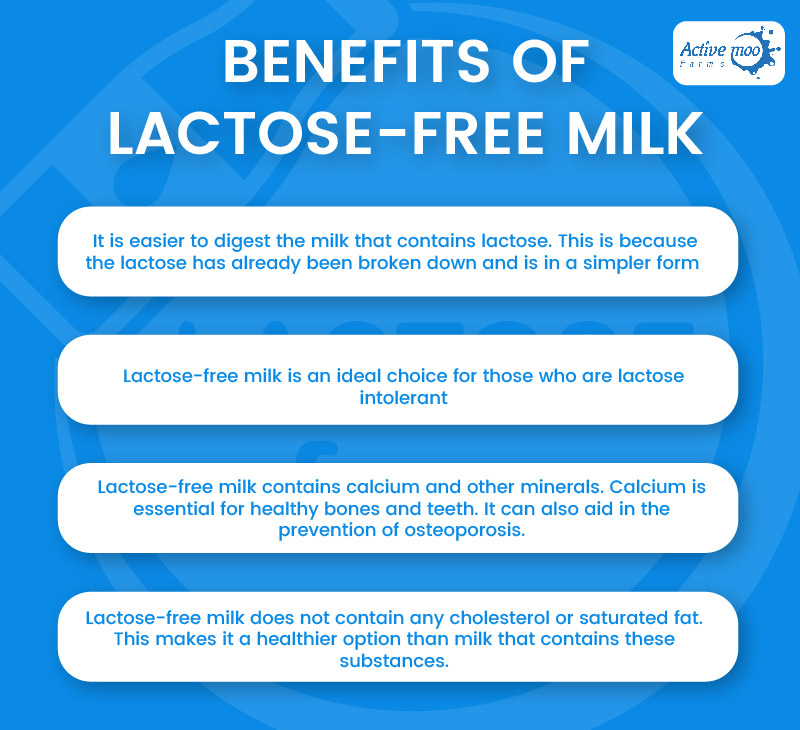Milk has always been advised for good health maintenance but there are many people who are allergic to milk and dairy products. According to studies, lactose-free milk is a great option for those who are lactose intolerant, and the benefits of lactose-free milk are the same as regular milk. It is made from milk that has been processed to break down the lactose into glucose and galactose. This makes it easier to digest for people who have difficulty digesting lactose. Lactose-free milk has the same nutrients as regular milk and is an excellent source of calcium, vitamin D, and protein.
What is Lactose-free Milk?
Lactose-free milk is milk that has no lactose, a sugar found in milk. Now understand the lactose free meaning, Lactose-free milk is prepared by eliminating the lactose from regular milk, making it safe for lactose intolerant persons to drink. Lactose intolerance is a disease that affects millions of individuals worldwide. Lactose intolerance implies that your body is unable to break down lactose, a sugar contained in milk. This might result in unpleasant symptoms such as bloating, gas, and diarrhoea. Lactose-free milk is prepared by eliminating the lactose from regular milk, making it safe for lactose intolerant persons to drink.
How is Lactose-free Milk Different From Regular Milk?
Lactose-free milk means it is a milk that does not contain lactose. Lactose-free milk is created by adding the lactase, an enzyme that converts lactose into two simpler sugars, glucose and galactose.
Lactose-free milk offers the same nutrient quality as regular milk, but it is simpler for allergic dairy persons to digest. Lactose-free milk is also a good choice for people who are looking for a dairy-free alternative to milk.
Lactose-free milk and regular milk are both dairy products, although they differ significantly. It tastes somewhat different from regular milk. Regular milk contains lactose, a sugar that some people have difficulty digesting. It also has a creamier consistency and a slightly different flavour.
Lactose-free milk is a healthy and convenient choice for people who want to avoid dairy allergies or lactose intolerance. It is also a good choice for people who are trying to lose weight or manage their blood sugar levels.
So, if you are looking for milk without lactose that is easier to digest, or you are looking for a dairy-free option, lactose-free milk is a good choice.
Lactose-free milk is also a healthy substitute for regular milk. It can be used in the same way as regular milk, so it’s a versatile choice for cooking and baking.
How Lactose-free Milk is Made?
When most people think of milk, they think of the white, creamy liquid that comes from cows. However, there is another type of milk that is becoming increasingly popular – lactose-free milk.
If you would ask, can you remove lactose from milk? Yes, lactose-free milk is made by removing the lactose from milk. In order to remove the lactose, the milk is treated with an enzyme called lactase.
This enzyme converts lactose into two simpler sugars, glucose and galactose. Once the lactose has been broken down, the milk is then pasteurised to kill any bacteria that may be present. The milk is then packaged and sold as lactose-free milk.
Also Read: Who Wants To Know The Mystery Behind MILK?
Benefits of Lactose-free Milk

There are several benefits to drinking lactose-free milk. First, it is easier to digest than milk that contains lactose. This is because the lactose has already been broken down and is in a simpler form.
Second, lactose-free milk is an ideal choice for those who are lactose intolerant.
Third, lactose-free milk contains calcium and other minerals. Calcium is essential for healthy bones and teeth. It can also aid in the prevention of osteoporosis.
Fourth, lactose-free milk does not contain any cholesterol or saturated fat. This makes it a healthier option than milk that contains these substances.
Overall, lactose-free milk is a fine option for those searching for an alternative to regular milk.
Lactose-free Milk: Pros and Cons
There are both advantages and disadvantages of lactose free milk.
Some of the pros of lactose free milk include that
- Lactose-intolerants will find it simpler to digest
- It has a longer shelf life
- It can be used in baking and cooking just like regular milk
- There are many health benefits of lactose-free milk such as no more bloating, digestive issues and diarrhoea
Some of the cons of lactose-free milk include that
- It is more expensive than regular milk
- It can have a different taste than regular milk
- Some people may still experience digestive issues after drinking it
If you are considering drinking lactose-free milk, it is important to weigh the pros and cons to see if it is the right choice for you.
Takeaway
Lactose-free milk is similar to regular milk, however it tastes sweeter. It breaks down the lactose sugar and makes it simpler for lactose intolerant people to digest. Lactose-free has comparable micronutrients but is significantly sweeter. Keeping in mind that it may still be unsuitable for individuals who avoid dairy products for other reasons.
Active Moo Farms is now introducing the best lactose-free cow milk to help build a strong and healthy body. Let’s grow healthy and fit!
FAQs
How Much Lactose is in Lactose Free Milk?
There’s a lot of misinformation out there regarding lactose-free milk and how much lactose it truly contains. Most brands add enough lactase to make the milk almost completely lactose free, but there can still be trace amounts. So, the lactose content in milk could be around (<0.1 g/L). However, the glucose and galactose content of lactose-free milk will be around 25 g/L.
Is Skim Milk the Same as Lactose Free Milk?
No, skim milk and lactose free milk are not the same. Skim milk is prepared by eliminating the fat from whole milk, however lactose free milk is made by separating the lactose.
Is Lactose Free Milk Healthier Than Regular Milk?
Some studies have shown that it may actually be nutritious. It only tastes sweeter. So, if you’re dairy allergic and looking for the healthiest option, lactose-free milk is probably the way to go.
How Does Lactose Intolerance Occur?
Lactose intolerance develops when the body does not create enough of the enzyme lactase, which is required to break down the milk sugar lactose. Lactose intolerance can be caused by a number of factors. First, some people are simply born without the ability to produce lactase. This is known as primary lactase deficiency. Second, some people may develop lactase deficiency later in life due to another condition, such as celiac disease or Crohn’s disease. Finally, some people may temporarily develop lactose intolerance after a stomach virus or other gastrointestinal illness. If you suspect that you are lactose intolerant, you should consult a doctor.
Does Lactose Free Milk Cook the Same?
When it comes to cooking, does lactose free milk make a difference? Many people are shocked to learn that it does not! Lactose-free milk cooks just like regular milk, so no alterations to your recipes are required. Of course, everyone’s body is diverse and some people may discover that lactose-free milk digests differently than ordinary milk. In terms of cooking, however, there is no distinction between the two. So if you’re looking for a lactose free alternative, rest assured that you can use it in all of your favourite recipes.




